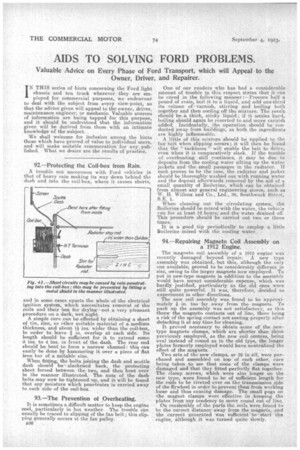AIDS TO SOLVING FORD PROBLEMS.
Page 18

If you've noticed an error in this article please click here to report it so we can fix it.
Valuable Advice on Every Phase of Ford Transport, which will Appeal to the Owner, Driver, and Repairer.
IN THIS series of hints concerning the Ford light chassis and ton truck wherever they are employed for commercial purposes, we endeavour to deal with the subject from every view-point, so that the advice given will appeal to the owner, driver, maintenance engineer, or mechanic. Valuable sources of information are being tapped for this purpose, and it should be understood that the information given will be derived from those with an intimate knowledge of the subject.
We shall welcome for inclusion among the hints those which have proved of value to individual users, and will make suitable remuneration for any published. What we desire are the results of practice.
and in some cases upsets the whole of the electrical ignition system, which necessitates removal of the eoils and their box for drying—not a very pleasant procedure on a dark, wet night. A simple cure can be effected by obtaining a sheet of tin, zinc, or other suitable material of a medium thickness, and about 14 ins. wider than the coil-box, in order to leave in. overlap at each side. Its length should be sufficient for it to extend some a ins. to 4 ins. in front of the dash. The rear end should be bent to form a narrow channel: this can easily be done by hammering it over a piece of flat iron bar of a suitable size.
When fitting, the bolts joining the dash and scuttle dash should be.'slackened back, the protecting sheet forced between the two, and then bent over in the manner illustrated. The nuts of the dash bolts may now be tightened up, and it will be found that any moisture which penetrates is carried away to each side of the coil-box.
93.—The Prevention of Overheating.
It is sometimes a difficult matter to keep the engine cool, particularly in hot weather. The trouble can usually be traced to slipping of the fan belt; this slipping generally occurs at the fan pulley. B36 One of our readers who has had a considerable amount of trouble in this respect states that it can be cured in the following manner :—Procure half a pound of resin, boil it to a liquid, and add one-third its volume of varnish, stirring and boiling both together and then cooling off the mixture. The result should 'be. a thick, sticky liquid; if it settles hard, boiling should agaan be resorted to -and more varnish added. Incidentally, the operation should be conducted away from buildings, as both the ingredients are highly inflammable.
A little of this mixture should be applied to the fanbelt when slipping occurs; it will then be found that the " tackiness" will enable the belt to drive, 'even when it is comparatively slack. If the trouble of overheating still continues, it may be due to deposits from the cooling water silting up the water jackets and the small passages in the radiator. If such proves to be the case, the radiator and jacket should be thoroughly washed out with running water and the deposit afterwards removed by the aid of a small quantity of Boilerine, which can be obtained from almost any general engineering stores, such as W. H. Willcox and Co., Ltd., 38, Southwark Street, S.E. 1.
When cleaning out the circulating system, the Boilerine should be mixed with the water, the vehicle run for at least 12 hours.' and the water drained off. This procedure should be carried out two or three times.
It is a good tip periodically to employ a little Boilerine mixed with the cooling water.
94.—Repairing Magneto Coil Assembly on a 1912 Engine.
The magneto coil assembly of a 1912 engine was recently • damaged beyond repair. A new type assembly was obtained,. but this, although the only one available, proved to be considerably different in size, owing to the larger magnets now employed. To put in new-type magnets in addition to theassembly would have meant considerable expense, which was hardly justified, particularly as the old ones were still quite powerful. It was, therefore, decided to experiment in other directions.
The new coil assembly vras found to be approximately 4 in. too• far away from the magnets. To pack up the assembly was not satisfactory, as this threw the magneto contacts out of line., there being a risk of the spring contact not seating properly after detaching it at any time for cleaning. It proved necessary to obtain some of the newtype magneto clamps, which are shorter than those previously employed, as the new coil centres, being oval instead of round as in the old type, the longer plates formerly employed would have neutralized the effect of the magnets.
Two sets of the new clamps, or 32 in all, were purchased and assembled on top of each other; care being taken to see that none of the clamps were damaged and that they fitted perfectly flat together. The clamp screws, which were also longer on the new type, were found to be of sufficient length for the ends to be riveted over on the transmission side of the flywheel in order to prevent them from working loose and thus causing damage. The small pegs on the magnet clamps were effective in keeping the plates from any tendency to move round out of line.
On reassembly of the parts thel coils were found to he the correct distance away from the magnets, and the current generated was sufficient" to-start the engine, although it was turned quite slowly.




























